Key takeaways:
- Green roofs enhance urban biodiversity, improve air quality, and reduce the urban heat island effect, contributing to healthier city environments.
- There are two main types of green roofs: extensive (low maintenance, thinner soil layer) and intensive (more lush, requires more maintenance), each serving different ecological needs.
- Design considerations include weight-bearing capacity, appropriate plant selection for the local climate, and effective water management systems to ensure a thriving ecosystem.
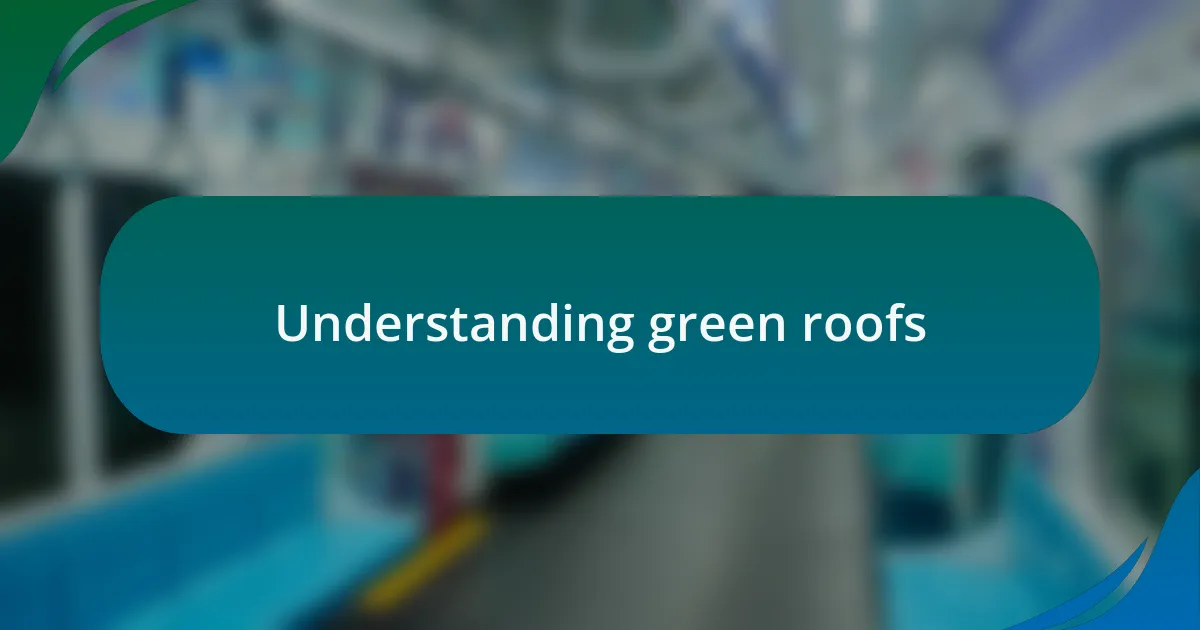
Understanding green roofs
Green roofs are fascinating structures that have become more than just a trend in urban architecture. I remember the first time I stood on a green roof—feeling the soft soil beneath my feet and observing how it transformed the skyline. It struck me how these living roofs not only provide beautiful green spaces but also serve critical functions such as reducing heat, improving air quality, and managing stormwater.
It’s extraordinary to think of the diversity of plants that can thrive in this unique environment. I once visited a rooftop garden filled with succulents and native wildflowers, which felt like a little oasis in the middle of the bustling city. Have you ever considered how these vibrant ecosystems could change the way we view urban landscapes? By integrating nature back into our cities, green roofs invite a sense of peace and connection that many of us long for.
Moreover, understanding the technology behind green roofs is also key. They consist of several layers, including a waterproof membrane, drainage, soil, and plants. This multilayered approach not only supports vegetation but also acts as insulation, further reducing energy costs. Imagine the potential for transforming entire neighborhoods—what if every building had a green roof? Just thinking about that possibility excites me because it could lead to a more sustainable and harmonious urban environment.
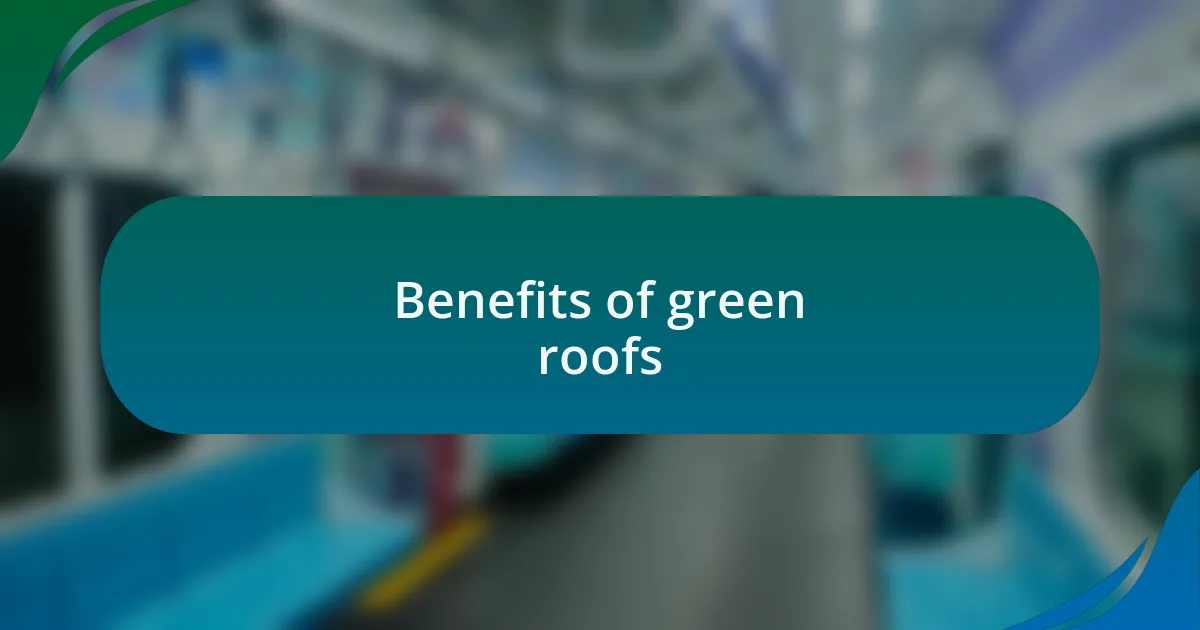
Benefits of green roofs
One of the most compelling benefits of green roofs is their ability to enhance urban biodiversity. I recall a time when I spotted butterflies fluttering amongst the native plants on a green roof—such a delightful reminder of the natural world tucked away in the city. Have you ever noticed how these spaces attract not just birds but also beneficial insects? It’s incredible how a rooftop can become a thriving habitat, positively impacting the local ecosystem.
In addition to supporting wildlife, green roofs significantly decrease the urban heat island effect. I’ve walked through cities during a heatwave and once noticed how unbearable the concrete felt, yet the areas with green roofs offered a refreshing coolness. It makes me wonder: wouldn’t it be amazing if every building could help lower temperatures in our neighborhoods? This cooling effect not only benefits residents but can also lead to reduced energy costs and improved thermal comfort indoors.
Furthermore, the stormwater management capabilities of green roofs are notable. I remember a sudden downpour while visiting a green-roofed building; instead of seeing water pooling everywhere, I noticed how it was absorbed by the plants and soil. This natural filtration system can reduce runoff and lessen the burden on urban drainage systems. Isn’t it fascinating how a few layers of soil can transform how water is managed in our cities?
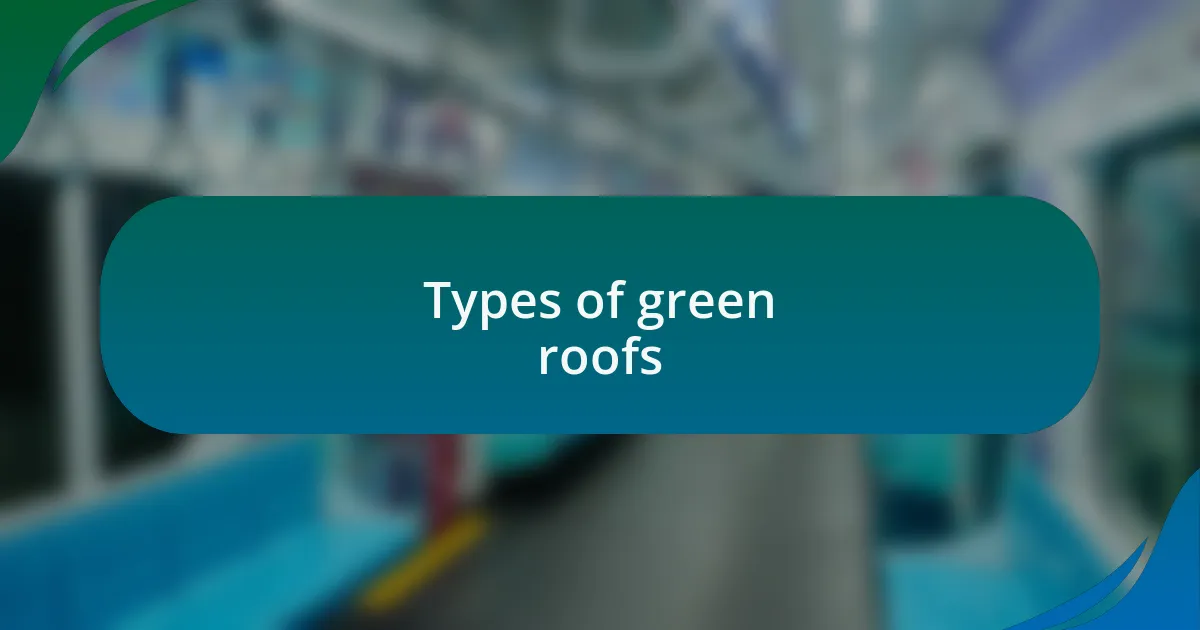
Types of green roofs
When it comes to types of green roofs, there are two main categories: extensive and intensive. I remember walking on an intensive green roof at a community center; the lush garden was filled with an array of flowers, shrubs, and even small trees. It was akin to stepping into a park high above the streets. Wouldn’t it be incredible to have that much greenery in our urban landscapes?
Extensive green roofs, on the other hand, consist of a thinner layer of soil and require less maintenance. I once visited a small café with an extensive roof that was mainly covered in hardy succulents. The vibrant, low-maintenance plants provided a burst of color and still contributed to stormwater management, much like daisies on a sunlit day. It’s amazing how even minimal soil depth can lead to such impactful ecological benefits.
Another type worth mentioning is modular green roofs, which feature pre-planted trays that can be easily installed and replaced. During my research, I came across a rooftop garden project using these modules, and the ease of installation seemed game-changing. Isn’t it fascinating how such a simple solution allows more buildings to easily integrate greenery into their designs? Each type offers unique advantages, making green roofs accessible to various projects and budgets.
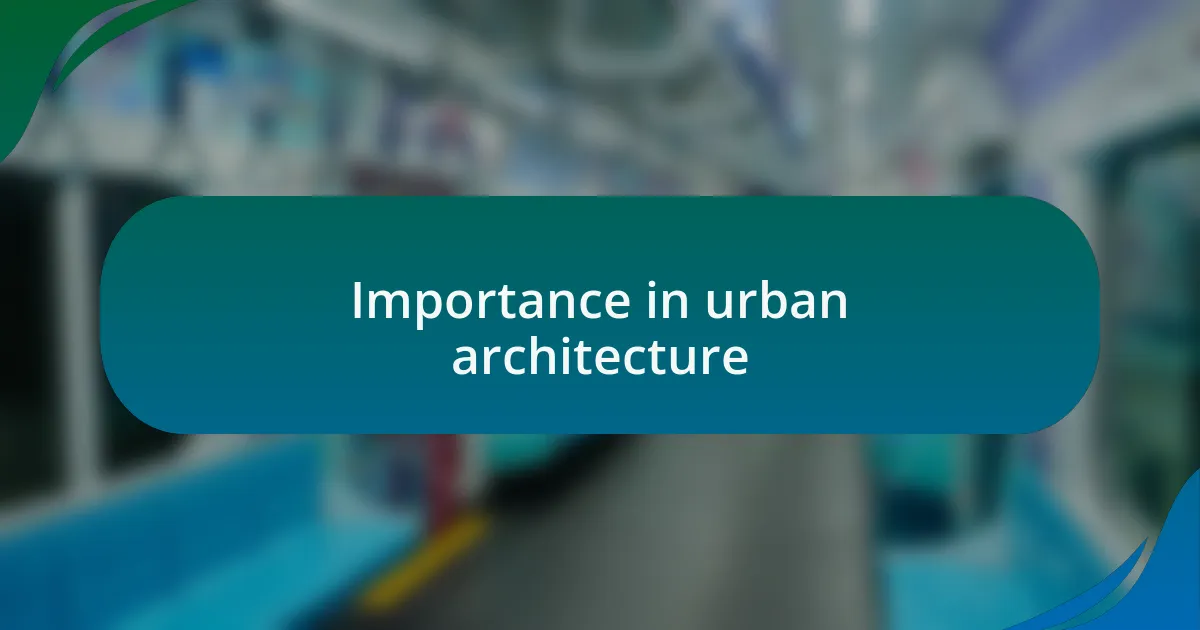
Importance in urban architecture
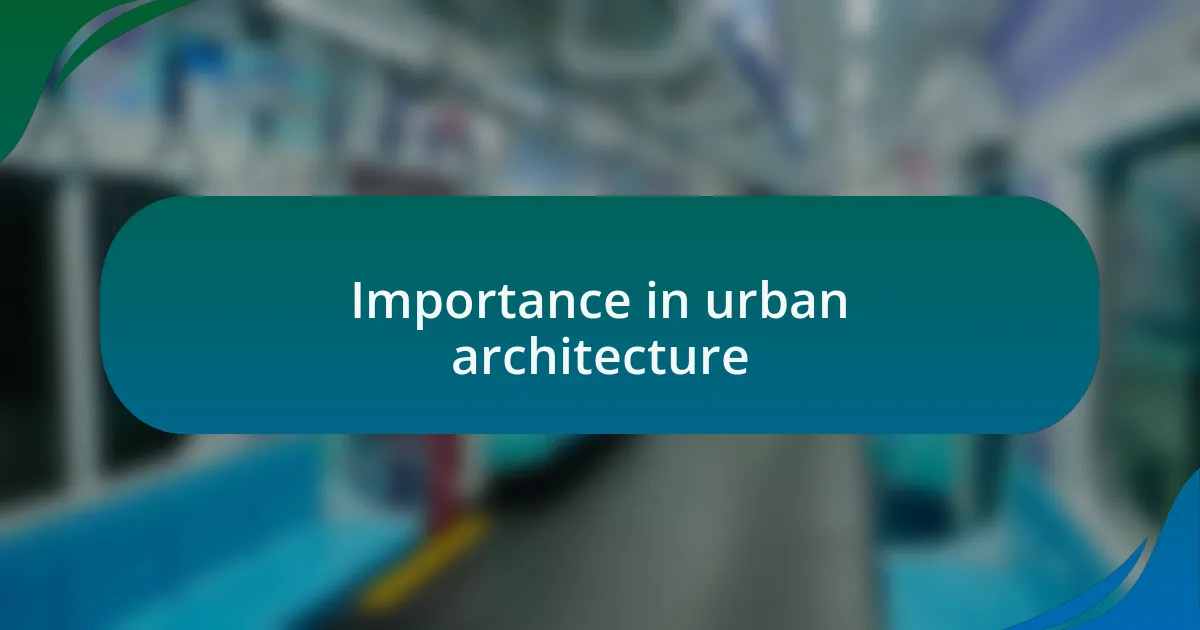
Importance in urban architecture
In urban areas, green roofs play a pivotal role by enhancing biodiversity. I remember visiting a building that had transformed its rooftop into a bird sanctuary, filled with native plants that attracted various species. Seeing the vibrant life thriving so high above the ground made me realize just how vital these spaces are for both nature and the city’s ecosystem. Isn’t it remarkable how we can bring wildlife back into our concrete jungles?
Moreover, green roofs offer significant energy efficiency benefits. After chatting with an architect who designed several eco-friendly buildings, I learned that these roofs can reduce heating and cooling costs. Just imagine saving money on energy bills while also contributing to a healthier planet! It’s a win-win situation that showcases the potential for sustainable design.
These roofs also improve air quality, acting as natural filters for pollutants. I recall attending a workshop where experts illustrated how plants can absorb harmful particles. It struck me that integrating green roofs not only beautifies our cities but also promotes public health. How often do we consider the impact of our architectural choices on our environment? Green roofs are a powerful reminder that thoughtful design can profoundly influence urban living.
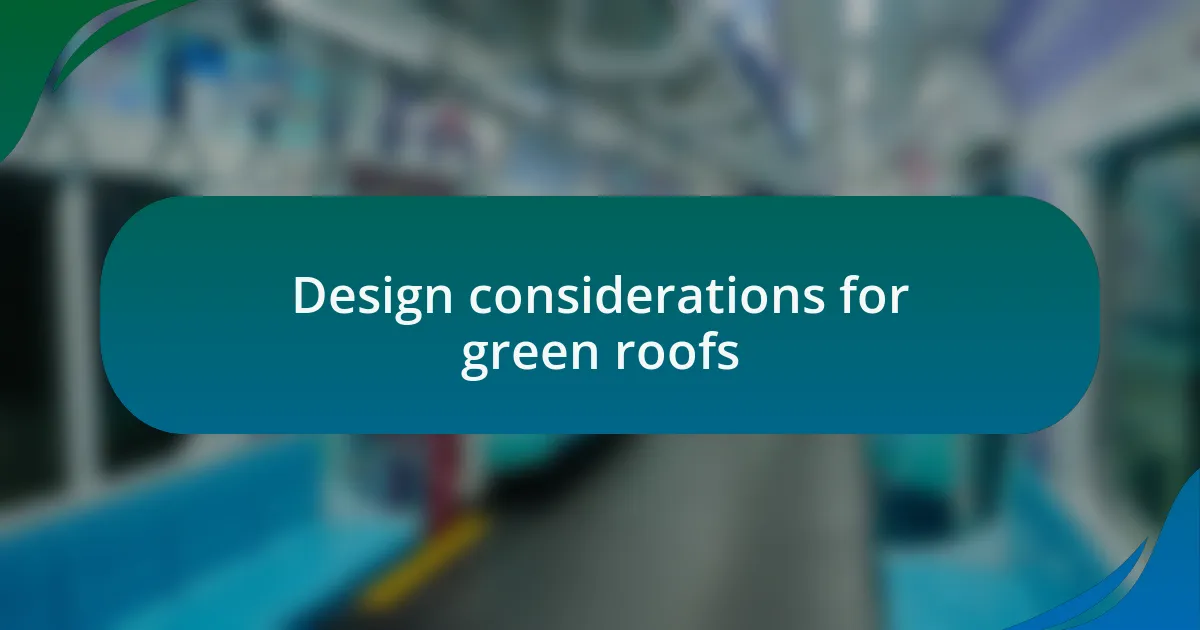
Design considerations for green roofs
When designing a green roof, it’s crucial to consider the weight-bearing capacity of the building. I recall a project where the structural engineer had to calculate the load to ensure the roof could support both the soil and vegetation. It was fascinating to see how architectural integrity intertwined with ecological ambition. Isn’t it essential to harmonize these aspects for a successful green roof?
Another key consideration is plant selection. I once visited a rooftop garden where the owner chose a mix of succulents and native grasses, perfectly adapted to the local climate. This thoughtful choice not only ensured lower maintenance but also created a stunning visual tapestry. Have you ever thought about how the right plants can transform a space while thriving in harmony with their environment?
Lastly, water management plays a significant role in the design of green roofs. In a recent conversation with a landscape designer, I discovered how incorporating efficient drainage systems can prevent water pooling and promote healthy plant growth. This insight made me realize just how vital it is to think about sustainability in every element of design. What could be more rewarding than creating a thriving ecosystem right above the bustling streets?